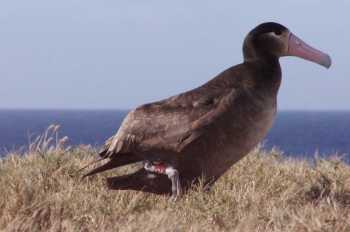Over the five-year period 2007 to 2011 70 globally Vulnerable Short-tailed Albatross Phoebastria albatrus chicks were taken from the species’ main breeding site on Japan’s Torishima and hand-fed on Mukojima in the Ogasawara Islands. Most of the 70 chicks fledged successfully from the island.
However, the ultimate success of a seabird translocation exercise is confirmation of the establishment of a new colony. This requires the fledglings to return to the translocation site and themselves breed successfully. ACAP Latest News has previously reported on breeding attempts by Short-tails in the Ogasawaras, including by a translocated bird (click here).
We now learn that a bird raised on the Ogasawaras on nearby Nakodojima (click here) has been reported on Mukojima after three years at sea. “The wild albatross with an artificially reared mother is believed to have left its nest on Nakodojima, one of the islands in the Ogasawara chain, in 2014, and migrated to the North Pacific Ocean. The bird was then spotted on Mukojima, an island north of Nakodojima, on March 1 [2017]” (click here).

A translocated and hand-fed Short-tailed Albatross fledgling on Mukojima
According to the report “four wild albatrosses have so far been born to artificially bred birds in the Ogasawara Islands”. Small beginnings perhaps, but with a second-generation bird returning to the translocation site things look promising for the establishment of a new (or even two) breeding colonies in time for the Short-tailed Albatross.
See also:
http://www.staradvertiser.com/2017/03/30/news/short-tailed-albatrosses-return-to-ogasawara-islands/
John Cooper, ACAP Information Officer, 07 April 2017

 English
English  Français
Français  Español
Español